Entries Tagged as 'Kelley'
It’s kind of difficult for me to attempt to describe what the Notting Hill Carnival was like earlier today. It was a complete and utter attack on all of my senses. I could feel the bass drum of the music reverberating throughout my body. I could smell the cooking smoke coming from the food-covered oil-drums-turned-grills. I could taste the spicy, tangy, smoky flavors of my amazing jerk chicken lunch. I could see the countless Jamaican and Trinidadian flags, Bob Marley posters, brightly colored clothing, vividly dyed pink-and-blue hair, and people of every race, religion, age, and size.
I realize that most of the people I saw at the carnival are probably tourists. I know that I heard at least four or five different languages, but I don’t think that it took away from the experience of the festival very much. Yes, there were places where you could buy “Imported Jamaican whistles” and Notting Hill Carnival 2009 t-shirts (probably both imported from China…), but the vendors in the center of it all seemed to be, to my unknowing eyes, pretty authentic. Salt fish, jerk chicken, curry goat, and plantains featured heavily on almost every food stall’s menu. Granted, there was the occasional Piccadilly Whip ice cream van and crepe booth, but in this day-and-age, I think that most everyone expects to be able to buy a soft-serve cone at an outdoor festival!
The thing that impressed me most about the carnival was how far things have come. When this festival started, it was a protest against the Police force for randomly stopping and searching young black men for drugs and other illegal substances. Apparently the Notting Hill Carnival has been so controversial between the Afro-Caribbean population and the Metropolitan Police that the bobbies tried to have it shut down until just a few years ago. Today I saw a large number of Police attendance, albeit they were doing their jobs, but they seemed to be having a good time. I saw one officer who looked like he’d been in the force when riots were at an all-time-high bobbing his head and swaying his hips to the infectiously happy music. Others were only too happy to oblige tourists by posing for pictures and allowing them to pet their horses. Despite the large number of tourists, I think that this was the best example of cooperation and the new ethnically diverse English identity I’ve seen since I’ve been in London. Thoughts?
Tags: Kelley
August 29th, 2009 · 1 Comment
Today we wandered, via the scenic route, over to the Victoria and Albert Museum in South Kensington. We knew that it would be an eclectic and eccentric collection, but we were in for a surprise…
Upon exiting the convient tunnel linking the Tube to several well-visited museums and sites in the area, we found ourselves in a ground floor sculpture hall. Randomly picking a direction to walk in, we wandered into in the fashion section. (Aidan and Brandon were thrilled.) In this collection we found everything from hautecouture to Elizabethan-era ensembles. Some of these clothes were truly shocking! One such item reminded Kelley of a woolly mammoth, but alas, it was a apres ski jacket. While we were lingering by a shirt made from a parachute and some heavily-sequined items, we could see into an exhibit of Raphael’s cartoons.
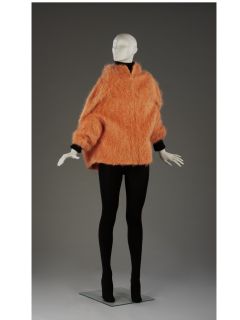
The Woolly Mammoth, erm, Apres Ski Jacket (picture taken from the website of the Victoria and Albert Museum)
A cartoon is a preliminary drawing for either a tapestry or a painting. In this case, the drawings were for a series of tapestries commissioned for Pope Leo X and they depicted a number of scenes from the Bible. We were impressed with the sheer size and careful preservation of the drawings. As one of the completed tapestries was present, it was also interesting to see what the finished product looked like.
We decided simply to wander from exhibit to exhibit in order to understand the Victoria and Albert collection as a whole. We were met with limited success. While the museum contains an extensive array of artifacts from around the globe, we found that there was no logical flow pattern in the museum. For example, we went from Korea to the European Cast Court (essentially a large number of copies of well-known facades and memorials) and again from finely-painted late 19th century tables to the radios of the 20th century. Essentially, we were confused. Why were these objects here and what is the purpose of their order? What is the collection of the Victoria and Albert trying to say to the visitor? It reminded Grace of a really nice yard sale. To Kelley, it was like searching around her grandparent’s basement. We found the artifacts to be very interesting and laid out well within their exhibits,we just question the museum’s purpose as a whole. That said, it was a worthwhile way to spend an afternoon. (We highly recommend going out into the garden and watching the children playing in the paddling pool!)
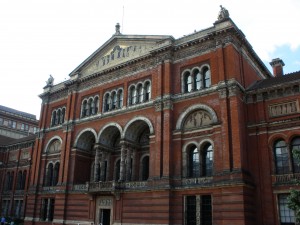
The architecture of the V&A from the garden
Tags: Grace · Kelley · Museums · Uncategorized
August 28th, 2009 · 1 Comment
After experiencing the National Gallery and the British Museum, the Tate Modern was shocking in and of itself. Compared to the beautiful architecture and classical feel of the other two galleries, the vast emptiness and cold steel of the Tate created an almost uncomfortable feeling. Meant to emphasize the artwork displayed, the white walls and dead space made us feel small.
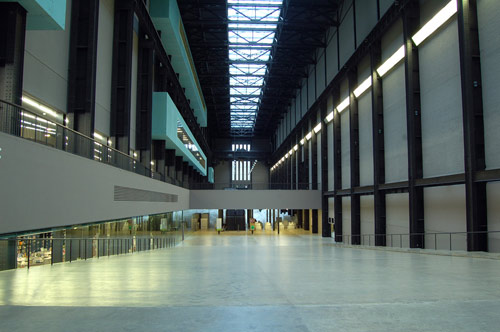
The entrance hall of the Tate Modern
The Tate was also much louder and more family-friendly than the other two museums. Children were sprawled out on the floor and benches, creating their own modern art. Graphic installations were clearly marked by both signs and museum employees. We were impressed by the museum’s effort to be open to all audiences.
Through a combination of choice and naivety, the three of us entered Paul McCarthy’s Projection Room. At first, we were simply disgusted and disturbed by the sexually explicit/grotesque imagery. The videos were so shocking that we can barely even remember what we saw. (For those brave at heart, just google image search “Paul McCarthy” for video examples similar in nature to the exhibit.) A brief peek at the Viennese Actionists exhibit didn’t help to settle our stomachs and minds, so we decided to leave.
Upon returning to the Arran House, we felt obliged to further research McCarthy in attempt to understand the meaning behind his “art.” We discovered he is mocking social rules and standards in addition to the media’s control (read: brainwashing) of our actions. Food and bodily fluid are his medium and his body is used as a paintbrush and a canvas. We found McCarthy views himself as separate from the Viennese Actionists. He states, “Vienna is not Los Angeles. My work came out of kids’ television in Los Angeles. I didn’ t go through Catholicism and World War II as a teenager, I didn’ t live in a European environment. People make references to Viennese art without really questioning the fact that there is a big difference between ketchup and blood. I never thought of my work as shamanistic. My work is more about being a clown than a shaman.”
We’ll leave you with this and let you interpret for yourselves McCarthy’s art and vision.
Tags: Alli · Kelley · Museums · Sarah
I am constantly finding myself in awe of something new in or about London. This morning’s subject of choice; statues. London has more statues than any other city I’ve ever been in, and I’ve visited my fair share. It’s not just the free-standing statues of Abraham Lincoln, Nelson Mandela, Winston Churchill, or General Montgomery that I saw just this morning, but also the finely-carved monuments and memorials to the Women of World War II, the Guard’s Memorial, and the Cenotaph. However, the greatest haven to carving in the British Isles I’ve encountered yet is Westminster Abbey.

- Westminster Abbey
Westminster Abbey is stuffed to the gills with statues and monuments to famous dead Britons. Sure, it’s kind of neat to see and praise the wonders of gravity at Sir Isaac Newton’s monstrous memorial, but is it really necessary for him to have such a large grave in a church full of other important people? On the flip-side to Newton’s tomb, Charles Dickens was buried in a very simple plot of ground… erm, church floor… that only recorded his name, date of birth, and date of death. Plain and simple, but did he really have any good reason for being buried in Westminster Abbey other than being a famous author? I was confused as to why these people, albeit extremely important in their own rights, would be buried in a place where they would have little-to-no affiliation with the Kings, Queens, and other nobles interred or no real connection to the Anglican faith. On that note, I also couldn’t help but wonder if any of the people buried at Westminster before the formation of the Church of England would be appalled to know their permanent resting place changed faiths on them! (Random thought, I know.)
After leaving Westminster, a group of us decided to go explore St James’s Park. As this was my first London park, I don’t have very much to compare it to. There were people everywhere posing for pictures, feeding the birds, chattering on in their native languages, and relaxing on park benches. The thing that struck me most about St James’s Park was the landscaping of gorgeous, brightly coloured flowers. They were so well tended-to and made the experience of strolling along extremely pleasant! There were also ponds with numerous types of water fowl and educational signs that showed pictures of what animals are indigenous of the area. However, due to the close proximity of Buckingham Palace and the Diana, Princess of Wales Memorial Walk located in the area, St James’s Park is definitely a bustling tourist attraction.

Flowers from St James's Park

Diana, Princess of Wales Memorial Walk
Just off of St James’s Park is the Churchill Museum and Cabinet War Rooms. I am a big fan of the history of Britain during World War II and the Blitz, so I was really looking forward to climbing into the depths of Churchill and the Cabinet’s own bunker. Thankfully, I was not disappointed! There was something very surreal about walking through the rooms with the provided audio guide and standing just feet away from where some of the most influential and comforting speeches of WWII were made by Winston Churchill.
However, the entire experience was not all sunshine and daisies. I had a big issue with the part of the bunker devoted to the Churchill Museum. Churchill was not a saint, please do not make him out to be one. There was little-to-no information provided on Churchill’s faults throughout the entire museum. I like Churchill as a historical figure and find much of what he accomplished in his various offices simply incredible, but he screwed up on more than one occasion. I was particularly frustrated with the portrayal of Churchill during the Dardanelles campaign during World War I. Churchill was the First Lord of the British Admiralty and in an attempt to “bring an end to the war quickly,” he sent Anzacs into battle poorly equipped and with incorrect maps. Although Churchill did resign in the aftermath, the museum would lead you to believe that the entire catastrophe that led to the loss of so many Anzac lives was not at all Churchill’s fault. (I also would have liked any information on Churchill’s relations with Ireland at the time of the Blitz, but alas, apparently it was not deemed as important.)
My day went from a fascination with statues in Westminster Abbey to walking in a building encased with steel and concrete. Although these things seem to be quite different on the surface, there is something that connects them; Churchill. They were Winston Churchill’s War Rooms and the Abbey bears a plaque commemorating Churchill. There is more than just this surface comparison, though. In times of great need, people turned to Churchill and to their church for reassurance.
Tags: Kelley
Upon entering Saint-Martin-in-the-Fields, early this afternoon for the E.L.F. trio, I thought I had a pretty good idea of what to expect from the concert and the church. I’ve been in a good number of European churches, and I admit that I’ve gotten a bit jaded on the church front. I wasn’t surprised by the decor of the church (Corinthian columns, gilded decoration, chandeliers, etc). It was quite typical of a church built in the mid-1700s. I was, however, quite enthralled by the window over the main altar of the church. Unfortunately, I couldn’t take a picture of it from the church, but it seemed to be purposely distorted into a display of modern art and it certainly made an interesting juxtaposition with the existing 18th century decor and architecture. (I was unable to find more information to tell if it is an original piece of the church or a more recent addition.)
The E.L.F. trio also managed to surprise me greatly! As much as I enjoyed it, I was notexpecting a 35 minute long tribute to Andrew Lloyd Webber’s Phantom of the Opera! Anyone else have an overwhelming desire to listen to the Phantom soundtrack after that?
The National Gallery was probably the highlight of my day. Anyone who knows me really well can tell you that I love music and theatre, but I’m not one much for old paintings. We were told that when we go to the British Museum we should keep in mind how the different artefacts relate to Great Britain. Along those same lines in the National Gallery I couldn’t help but keep thinking about how the paintings managed to get to London. The ones that were by British artists or of Britain or by an artist from the Empire made sense, but how did they get such a large number of paintings from Germany, the Netherlands, Italy, etc.? What really shocked me were the 13th to 15th century paintings that used to be altarpieces in churches. There was one by Filippino Lippi, called The Virgin and Child with Saints Jerome and Dominic, from about1485 that was painted for San Pencrazio church in Florence. How did these pieces of art from the walls of churches manage to get to London? I just had a bit of an issue getting my head around the idea that so many of these fragile pieces of artwork were cut up and shipped to London museums from places that were outside of Britain’s sphere of influence.
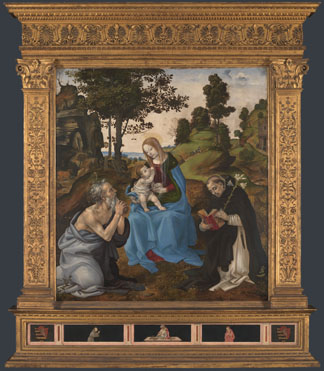
The Virgin and Child with Saints Jerome and Dominic by Filippino Lippi - picture taken from the website of the National Gallery
As I said above, I am not one who is a big fan of looking at old paintings for hours on end, but I know the big names and can recognize my fair share of famous paintings. One of the things I appreciated and was in awe of most about the National Gallery was the sheer volume of paintings they had that I was familiar with. There was one room with twenty-one paintings on the walls and I counted nine by Raphael and two by Michelangelo. (I came to realize that you could tell where a really famous painting or artist’s work was when there was a massive group of people surrounding it and traffic stopped flowing.) The US has some really nice art museums, but the content of the National Gallery blew my mind.
The main thing I learned today is that art and music transcend all language barriers. I probably heard people speaking at least a dozen different languages when I was strolling around the National Gallery and sitting in Saint-Martin-in-the-Fields, but it didn’t matter because everyone can enjoy art and it is completely open to interpretation.
Tags: Kelley
When I first left Tower Hill Tube station and looked out over the road to the Tower of London, my first thought was “I really wish those cars weren’t driving on the road so I could get a clear picture.” Then I managed to get over my disappointment, reminding myself that I will be going there eventually and will be able to take pictures in abundance, I looked around and noticed the section of Roman Wall standing less than 100 feet to my left. I admit, knowing the importance of the Romans and the impact their wall had on the development of today’s London, I feel kind of silly for letting my eyes slide over it to the prettier and more picturesque Tower. That written, I think that my mistake of dismissing the wall as nothing but an unimportant ruin happens to countless tourists and even the people of London every day!

Roman Wall my eyes skimmed in favor of the Tower of London
What I found most interesting about the Roman Walk was the idea that London is a modern city built on top of several stages of ancient city. The fact that the basement of a hair salon can house Roman ruins is difficult to fathom. However, the knowledge that people in the medieval ages recognized the brilliance of Roman engineering and decided to fortify and expand the existing wall is even more incredible.

Medieval section built on top of Roman Wall - complete with pigeons!
When I started my second of two walks of yesterday, I didn’t know very much about the area or the people who have lived there. Although it was really neat to see where this writer and that philosopher worked and played, I was much more interested in the buildings and how they related to the history of London. There was one section of the tour that particularly captured my attention. When standing in the centre of one of the green spaces, you could look to one side and see original row houses, with the dark brown brick and white window frames, and to the other side you could only see bright red brick houses that seemed to have been completed in the last five to ten years. The original houses that still stand were only cosmetically damaged during the Blitz; while the red brick homes had been completely annihilated. What shocked me was that only a small span of grass and trees separated the barely injured and the completely destroyed.

Original rowhouses that were barely damaged in the Blitz

New red brick rowhouses where old ones were destroyed in the Blitz
Today at the Docklands Museum, the City and River: 1800-1840 exhibit really stood out. I’m not a huge fan of taxes and duties, but there was a section on customs and why the docks had to be formed that made a lot of sense to me. It explained that there was so much illegal shipping into London through unauthorized channels that something had to be done by the government to try to control it/use it to their advantage to get more money through taxes. What I found particularly interesting was that the proprietors of the different docks were paranoid of each other to a fault. They didn’t trust the police to look after their docks and warehouses, so they hired personal security forces to keep out anyone they didn’t want around. After seeing the different wharfs and how close they were to each other when I went up to Greenwich the other day, I completely understand the paranoia of the businessmen.
Even though I’ve been in London for only four days, I feel like I’m slowly beginning to understand that there is much more the London than I could have possibly imagined. I’m learning that I need to keep my eyes open because you never know when you’ll turn a corner and find the next nugget of history, culture, art, or architecture.
Tags: Kelley
We left the Arran House bright and early at 8am. Together, we boarded the tube and set off for East Aldgate in search of the Whitechapel Market. This proved to be much more of a hassle than we had imagined. As we left the station and entered the streets of Whitechapel, our first perception of the area was the large, pristine East London Mosque, featured below.

From that moment on, we observed many bilingual street signs (in Arabic and English) and small family owned businesses including flower shops, restauraunts, and news agents.

Though there were a plethora of shops, there was a distinct lack of people. We were perplexed by the quiet streets and closed stores and were still unable to locate the elusive Whitechapel Market. Thankfully, a mailman was able to calm our fears…by telling us that it did not exist. He instructed us to walk a few blocks to Commercial Street where we could visit Spitalfields, a predominantly Islamic market. This also proved to be a disaster: it was closed, as we later found out from Professor Qualls, due to the beginning of Ramadan. Below are a few pictures of the deserted market which we imagined, under different circumstances, would otherwise be a vibrant and exciting community.
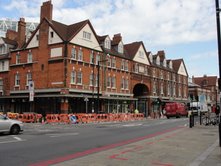
This is the exterior of the Spitalfield Market!
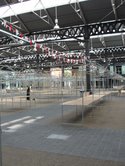
Here is the interior of the deserted market.
After another panicked call to Professor Qualls, he then directed us to Leadenhall Market which we located on the outskirts of London Proper. Originally a market for fish and cheese mongers, it was established in 1321 as a meeting place for vendors. However in 1666, parts of the original building were destroyed by the Great Fire and then later rebuilt in both 1881 and refurbished in 1990.
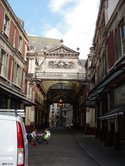
This is the entrance into the Leadenhall Markets.
Below is an image that captures the amazing architecture of the market place which is clearly incredibly ornate and a far cry from what we saw in Whitechapel. Not only were there high-end retail stores, but also high-rises and the buildings and streets were noticeably cleaner.
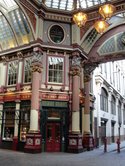
Here is an example of Leadenhall Market's interior!
Despite the fact that the markets were closed, it was still a very enlightening experience, for we saw two different Londons. The first being a predominantly immigrant community that combined the traditional culture of their homelands with the western ideals of Britain. The second was a more commercialized section of the city and felt more like a mainstream city center. It lacked, however, the intimate nature of Whitechapel. All in all, this experience helped us realize the economic and cultural diversity of London!
Tags: Kelley · Kimberly · Maddie · Markets
I love UNESCO world heritage sites and am thrilled to be able to count Maritime Greenwich among those I have visited! I honestly didn’t know what to expect before going to Greenwich this morning. I knew that there was an observatory, which meant that there was at least one really big hill, and the Prime Meridian, which my mother had requested I take a video of myself dancing on (yes, I did and it’s a long story).
What struck me first at the observatory was the practical elegance of the buildings. The original observatory, designed by Christopher Wren, had a beautifully decorated dome that was perfect for viewing the sky, but it also had the necessary living quarters for the Royal Astronomer. My favorite exhibit in the observatory museum was of the clocks. I found it really interesting to see the progress of clocks over time and the timepieces used in specific jobs to this day (ex. the diver watch and the Underground/Bus driver clock). I didn’t know that wristwatches were seen as feminine before WWI, but were found to be more practical in the trenches, causing men to adapt them.
After lunch, Chelsea and I headed over to the Maritime Museum and spent a fair bit of time wandering around the exhibits. In one of the rooms there was a really neat display that showed Butler’s Wharf (which we passed on the boat) as it was in 1937 and then again in 1997. It was very clear to see the development that happened over that 60 year span. In 1937 it was a heavily worked dock and warehouse area, while in 1997 it had been converted to luxury apartments. That display illustrated the expansion of the upper-middle class city into what had been a very working class area.
One of the other rooms in the Maritime Museum that I found fascinating was the reconstructed stained glass from the Baltic Club. The Baltic Club was a high-end club in the center of London and it was bombed in 1992. This exhibit showed the damage that had been done to the windows and what the conservationists had to do in order to restore them to their original state.
Greenwich Market was a curious place. It had just about everyone and everything you can think of: different languages being spoken, ethnic crafts, clocks made out of vinyl records, jewelry, lots of soap/incense places, and, of course, food. It didn’t take me too long to get through the market, but it was very charming. After the market, Chelsea and I, after much searching and walking, managed to find a 188 bus stop that was not closed for construction. Neither of us had really been on a bus in London, so we figured it was as good a time as any to figure out the system. A very long bus ride later, we got the Russell Square and made our way back to the hotel.
Tags: Kelley · Markets · Museums
Starting our first of what’s bound to be many exhausting days, Team Grace Kelley journeyed to the far-away land of Piccadilly Circus via the Tube. We found the Tube to be easy, efficient, and foolproof. Our trek began at Goodge Street Station and took us to our transfer point at Leicester Square and on to Piccadilly. When we got off the train, we followed the clearly marked “Way Out” signs, right into the tourist heart of London. In front of us was a fountain and statue of Eros, commemorating Antony Ashley Cooper, Seventh Earl of Shaftesbury, for his philanthropic work. The monument was surrounded by tourists of every shape and size! As we wandered around the statue and the area, we heard at least six or seven different languages. People were taking pictures on the stairs of the statue and the Ripley’s Believe It or Not employees were “performing” for the tourists.
One of the more noticeable features of the Circus, or circle, was the juxtaposition between the Regency style architecture and the neon/plasma screen advertisements on the sides of the buildings. The Regency style uses a lot of white stone facades and vertical lines. This style was first implemented by John Nash and inspired interior decoration, as well as fashion trends (ex. pier waistline for women). It includes an abundance of rod-iron balconies and windows and uses symmetrical shapes, having similar elements to the Georgian style of architecture.
Piccadilly Circus, established in 1819, was named for Pickadilly Hall, the residence of a famous tailor who was known for selling the piccadills-style collar. Its central location in the City of Westminster makes it an ideal meeting spot and one of the most well-known places in London. Here tour buses, the Underground, and city buses converge at a fast pace onto the crowded streets. However, we encourage walking and found it a very easy journey back to the Arran House.
Piccadilly Circus is a tourist trap, but it one worth seeing… watch out for pickpockets!



Tags: Grace · Kelley




















